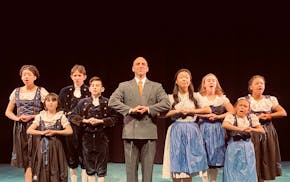On Monday, Twin Cities actor and writer Sha Cage won an Ivey award for her outstanding performance last fall as a drone fighter pilot in George Brant's "Grounded." On Thursday, Cage previewed "U/G/L/Y," another solo show, but one she crafted herself from family stories and interviews with women about what they see when they look in the mirror.
The one-act, directed by her husband, E.G. Bailey, and playing at the Guthrie Theater's Dowling Studio through Sunday, is a milestone show that keeps company with Ntozake Shange's landmark "For Colored Girls Who've Considered Suicide When the Rainbow Is Enuf" and Kirsten Child's playful "The Bubbly Black Girl Sheds Her Chameleon Skin."
"U/G/L/Y" is not pitched to particular audiences, although it is clearly grounded in Cage's history and the genealogy of strong family women she lays out in the show. Cage is an African-American artist from the rural South, but hers is a broader piece about the psychic costs of beauty standards through the centuries that are now enforced by Hollywood and media. (The production uses video images by Sherine Onukwuwe, including women with bound feet, prodigious behinds and vitiligo.)
Nor is this a bitter rant against the unfairness of it all. In an age of social media self-promotion — over-sharing that sometimes reinforces the archetypes she seeks to escape — "U/G/L/Y" is delivered without affect. This honesty, and some humor, makes it a moving and necessary piece of theater, not simply for the women snapping fingers in agreement at Thursday's preview, but also for all who care to understand.
The enacted stories include one about a young lady who dreams of her Prince Charming (a Mandingo one) before the dream is shattered. Another vignette involves Cage as a silent screen figure, with long, oversized shoes, coming out to entertain. Then there's the woman whose boyfriend would not let her go, and who, three years after they last dated, meets him again with tragic consequences.
Accompanied by violinist Katherine Pehrson, Cage performs on a mostly bare stage that is evocatively lit by Michael Wangen. The two performers have a playful interaction that also points to the occasional levity in a show that begins in the shadows near a shrine of herbs and African masks. There, Cage, under a blanket, rises from the ground. Her movements are labored as she struggles, limb by malformed limb, to shed her wrapping. She could be a mythical creature rising from the sea, or a homeless person waking in Minneapolis.
That image presents a metaphor for the show's themes. What follows is a powerful and, at times, elegantly beautiful exploration of the struggle to be one's true, honest self.
rpreston@startribune.com • 612-673-4390
'A Year With Frog and Toad' closes a chapter at CTC

Review: Artistry's 'Sound of Music' continues buoyant comeback for Bloomington playhouse
Penumbra Theatre sets up to score with hoops dream play 'Flex'

A former deli maestro steps into Capt. von Trapp's shoes in Artistry's 'Sound of Music'


